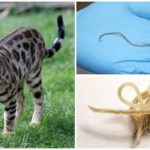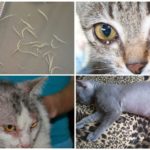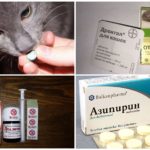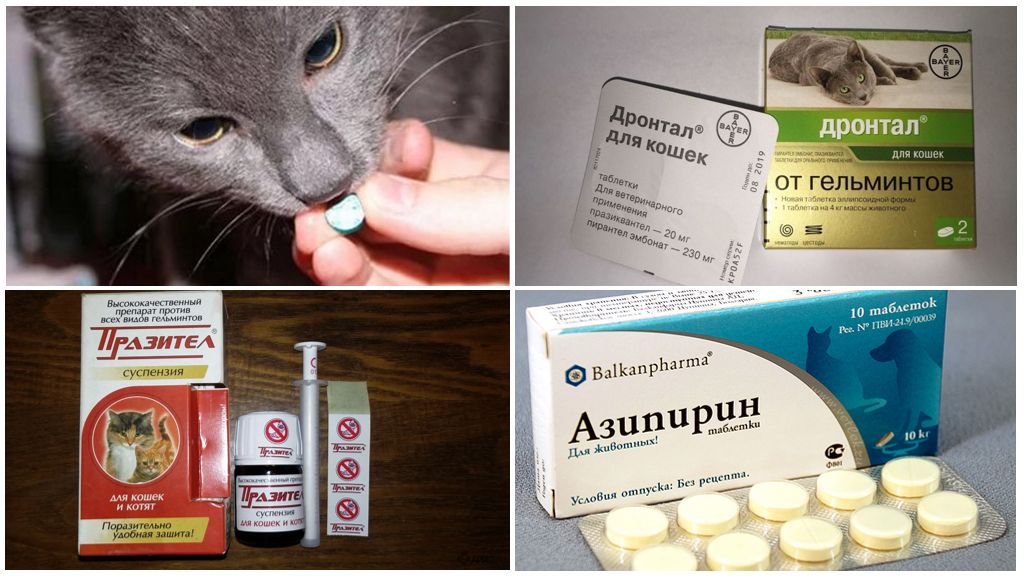Symptoms and treatment of ascariasis in cats
Content
- Ascaris in cats
- Signs of Ascariasis in Cats
- Treatment of Ascariasis in Cats
Even with adequate care, pets are at risk of infectious and parasitic diseases. Roundworm in cats is the most common worm infestation. The danger of an illness is that the fluffy pet does not begin to disturb its symptoms immediately after infection, but when the parasite has already spread throughout the body. After the diagnosis, the owner has a fear of being infected with worms, and he does not always know how to help the cat.
What is ascariasis
Ascariasis (or toxocarosis) is a parasitic disease that is caused by worms of the genus Toxocara. These worms are extremely common in the environment, animal reservoirs are becoming a reservoir. In the city, the probability of infection is greater than in rural areas.
In cats, the disease occurs when a representative of one of three types enters the body:
- Toxocara cati (Toxocara mystax);
- Toxocara leonina;
- Toxocara canis.
T. cati infection is considered the most common cause of the disease, and T. canis is a rare cause, since this is a type of pathogen common among dogs.
Important!
Parasites enter the body of the animal in one of three ways: by swallowing eggs, eating mice infected with Toksokara, or by transmitting from mother to the fetus during pregnancy, feeding the kittens with milk.
If you look at the photos of ascaris in cats, you will notice that these parasites resemble pasta. They are translucent, have gloss and slightly yellowish coloring, the body is pointed from two ends. The causative agents of ascariasis are dioecious. The length of individuals is from 3 cm (males) to 10-15 (females). The owner of the cat may notice them in the toilet tray after defecating the animal.
The life cycle varies depending on the type of helminth.When infected with Ashorida Toxocara cati, the animal swallows the helminth eggs with food or water, while eating the intermediate host. The larva leaves the egg and penetrates the intestinal wall, penetrates the blood vessel from there, and with the blood flow enters the lungs, the trachea, the central nervous system, the eyes. Ascaris larvae can again be swallowed by a cat with sputum when coughing. The development of worms to the state of an adult individual and reproduction occurs in the intestinal lumen.
Infection of the cat Toxocara leonina occurs in a similar way. The female worm lays its eggs in the intestinal lumen. They enter the environment with excreta, then swallowed by animals. From the egg emerges a larva, which gradually develops, several times endures molting. Mature causative agents of ascariasis mate, the female lays eggs.
On a note!
Worms are extremely prolific. In 1 gram of cat excrement can be found up to hundreds of thousands of eggs. When released into the environment, larvae take up to 3 weeks to mature. The eggs themselves can remain viable on objects in the soil for up to several years.
Signs of Ascariasis
In adults, the disease is often asymptomatic, even a caring owner will not be able to suspect the presence of worms. It is most dangerous for kittens due to the rapid development of intoxication.
Symptoms of ascaris in cats may resemble other diseases:
- the pet becomes sluggish, does not play;
- appetite is disturbed: it is reduced or increased;
- the pet is stunted, has less weight than healthy ones;
- upon examination, one may notice an enlarged, “bloated” abdomen;
- wool becomes dull, untidy;
- diarrhea, episodes of vomiting;
- the itch in the field of an anus is possible, the cat tries to appease him, licking;
- fever;
- discharge from the eyes.
On a note!
When ascariasis develops sensitization of the body with allergic skin reactions, the appearance of crusts around the eyes, nasal openings. Also, a worm lesion leads to anemia - during the inspection, the pallor of the skin and oral mucosa is visible.
With the defeat of the lungs, pneumonia occurs, the cat coughs. If the amount of ascaris in the intestinal lumen becomes significant, obstruction develops with constipation and an increase in intoxication.The release of parasites into the abdominal cavity leads to peritonitis. This condition is life threatening for the cat.
If the larvae block the biliary tract, infect the liver, jaundice occurs.
Since the symptoms of roundworm in cats are non-specific, it is necessary to examine the animal in a veterinary clinic. This will help eliminate other dangerous diseases and promptly prescribe treatment.
Invasion will be indicated by detection of ascaris in feces. In the laboratory, take the analysis on the eggs of the parasite. If a single study of the material did not give the desired result, it should be repeated up to three times with an interval of 7-9 days.
Treatment of Ascariasis in Cats
For the treatment of ascaris in cats, the veterinarian will prescribe anthelmintic drugs. They help get rid of parasites with a probability of 90%.
Important!
Self-administration of any medication is dangerous for special categories of animals - kittens and pregnant cats. Therefore, a specialist will pay attention to the owner of a fluffy purring, how and what can be treated. Kittens are prescribed anti-ascaris drugs at the age of 3 weeks. In pregnant cats, anthelmintic drugs are possible in the second half of the term.
Among the popular drugs:
- Drontal tablets;
- Prazitel suspension;
- azipirin tablets;
- Cannavtel gel and tablets;
- Milbemaks tablets.
If during the treatment of ascaris, the owner of the cat noticed a change in the condition of the animal: it becomes sluggish, inhibited, vomiting appears, you should immediately contact the veterinary clinic. Possible marked individual reaction to drugs.
In case of severe intoxication of the animal against the background of a lesion by ascaris, droppers are prescribed under the supervision of a specialist. If the cat develops intestinal obstruction against the background of blockage of the lumen with worm lumps, surgical intervention will be required.
Important!
Given the prevalence of ascaris and the high incidence of infection, any kitten who entered the house as a potentially sick person should be considered and given parasite medications even in the absence of an invasion clinic.
When detecting helminths in a cat, a general cleaning of the house with chlorine-containing agents should be carried out; all the places where the animal could have been kept should be carefully treated, a bedding bowl, and bowls.
Disease prevention
Observance of simple measures will protect a cat from dangerous helminthiasis:
- Keeping cat litter clean.
- Feeding the animal with special dry food.
- Timely treatment of fleas.
- Regular wet cleaning, storage of outdoor shoes in an inaccessible place.
Important!
For the specific prevention of ascaris, anthelmintic drugs are given to the cat once every 3 months. The treatment is carried out even in animals that are not in the free range.
Is it possible to infect a person from a cat?
Roundworm is really transmitted to a person upon contact with a sick animal. Infection is promoted by close “communication” with a cat and neglect of hygienic procedures. After stroking, playing with the animal should immediately wash your hands with soap and water.
But helminths that affect cats are characteristic of this species. A person for them can only act as an intermediate host, the full life cycle in his body is impossible.
The parasite's larvae enter the intestines, from there they spread to the internal organs of the person (eyes, lungs, nervous system, liver), where they can be in an encapsulated state for a long time without showing themselves.
Important!
If the child becomes infected with ascaris from the cat, symptoms of intoxication, nausea, vomiting, loss of appetite, cough may develop.
The disease of ascaris in cats is possible with free walking, eating rodents, contact with the shoes of the owner. Kittens "receive" the helminth in utero or through mother's milk. For prevention, animals should be given anthelmintic drugs 1 time in 3 months. When contacting a cat and detecting in oneself or close symptoms of an indisposition, contact an infectious disease specialist.











